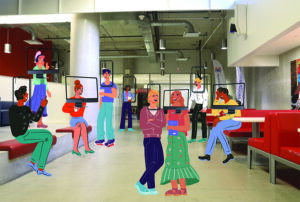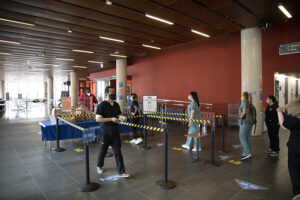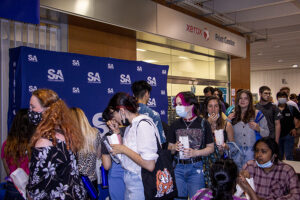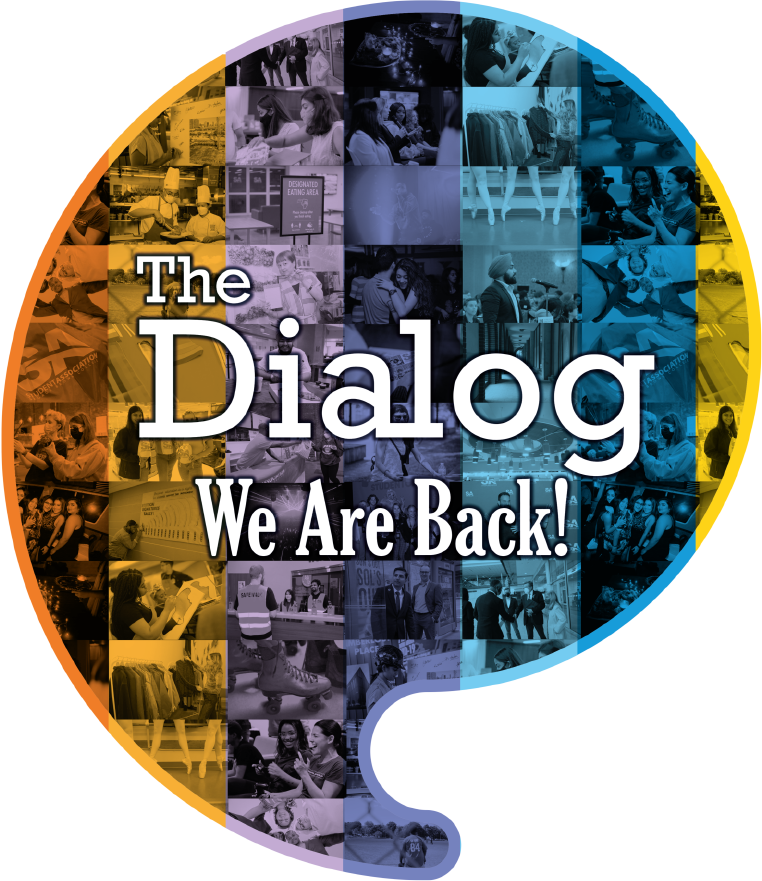Returning to campus after two years is a dream students and staff have strived towards since the pandemic started.
Welcome back.
Our campuses for too long, have been reminiscent of a ghost town. The usually bustling hallways empty, the once filled classrooms yearning for a lesson to be taught.
As we stand on the precipice of a new year, we at the Student Association of George Brown College (SAGBC) speak for everyone within the community as we say, we are so excited to see faces return to campus and life return to our world class institution.
As everyone within the George Brown College (GBC) community navigated the new normal which descended upon us over the last two years, we are more than happy to look towards the future, while also remembering exactly what the world went through.
In March 2020, the province of Ontario issued a state of emergency, closing schools and shuttering non-essential businesses, as a means to curb the pandemic making its way around the world.
This move shocked and confused staff members of the SAGBC like Rosalyn Miller, general manager, who had to quickly pivot to deal with the sense of panic that most people were feeling.

Graphic by: Kinjal Chheda
“Two and a half years later, as I reflect on the college’s closure, [and the] country shutting down, it was an absolute sense of panic. Because we were not an organization set up for digital or virtual events, we did not have connections on platforms like [MS] Teams or Zoom. We were a 100 percent brick and mortar organization. And so, to imagine that there’s a shift to online and we did not have the systems in place was a bit frightening. However, we knew that our staff, our team and the George Brown community are resilient, we’re adaptable. And so, we adapted very quickly. We stay connected through social media platforms. To our student body, and then we quickly implemented, develop the systems to be able to program and service our students,” said Miller. “Our biggest concern was the stress and the impact that our student body would be feeling and that they weren’t able to reach us or connect and get the support and resources. We were really concerned about being able to not provide food to the students that we know are dependent on us for the food programs. We did have to pause, but I am so proud of how we were able to reconfigure all our programs online that we were actually able to enter into agreements with delivery companies, and that we were able to safely distribute, whether that be food gift cards, or delivering pampers to students across the entire GTA.”
For the last 2.5 years, students and staff have had to face challenges beyond adapting to the new normal.
The COVID-19 pandemic took students, staff, and other members of school communities out of the classroom, putting them into situations where they not only had to navigate learning new information in their courses but also had to contend with understanding the virtual learning world.
It wasn’t just post-secondary education students who had to deal with these changes, as those in high school and even elementary grades were put to the task of understanding how to learn via their digital devices and completing projects in time for graduation.

The Student Association found many ways to connect with students during the pandemic, like giving out grab and go lunches. Photo by: Halley Requena-Silva
While attempts were made to return to campus at points over the last two years, the pandemic had other ideas, keeping us apart when so many wanted to be together. This distance, something most students have never had to experience before, brought with it a set of unique complications – ones that impacted mental health.
The hardships of being separated from fellow classmates as learning took place, of being stuck inside and only seeing friends through a computer screen, took their toll on students. The isolation and distance impacted students and their learning ability around the world, affecting more than 1.6 billion students from across 150 countries.
In a scientific article published in Prospects, Suzanne Lischer notes that students may be experiencing more psychological effects from the pandemic including anxiety, fear, worry and other similar feelings. Lischer continues by saying students in the winter term following the onset of the pandemic were more sedentary, anxious, and depressed.
The National Alliance on Mental Illness (NAMI) notes that nearly three in 10 students were experiencing harm to their mental health because of social distancing and closures. Another 14 percent were said to be reaching their limits before their mental health would suffer.
For students who may still be feeling some added pressure or anxiety as they return to on-campus learning, the Health Benefits service has the Student Assistance Program (SAP).
For students in need, the WeConnect SAP provided through Health Benefits can connect those in need with counselling, health coaching, legal advice and even financial coaching. The program, launched in September 2021, has many benefits for students who may be feeling some extra stress says Yukiko Ito, senior coordinator of health benefits.
“WeConnect is offering worldwide [services, so even] international students outside of Canada can [gain access] to counselling services,” said Ito. “A student under the plan, either domestic plan or international post-secondary program… can access WeConnect which is a student assistant program. So, all they have to do is they need to go to WeSpeakStudent, which is our provider’s website and choose George Brown College in the main page.”
She says anyone needing counselling or other assistance can call and access the service 24/7 once they are registered.
As life returns to campus, students may need some added support outside of their mental wellbeing.
In terms of supporting students with scholarships and other charitable programs, the GBC Advancement team was faced with the big issue of not being able to raise good amounts of money.
While students’ needs such as employment, food security, and housing were increasing during the pandemic, there was a serious challenge in finding donors.

Cindy Gouveia, vice president of advancement, spoke at the first GBC meet and greet luncheon since the pandemic, on July 28. Photo by: Sean Heeger
“The first year of COVID was very tough for students… and on this side of the house, we had a really hard time engaging with donors because everything was shut down, including their own businesses,” said Cindy Gouveia, vice president of advancement.
This challenge, however, was slowly overcome when people resumed business and began to notice how difficult it had been for students to sustain without help. Gouveia says the advancement team made as many interactions with donors as possible, given the social-distancing measures.
She revealed further that they have already raised a record amount of donations so far this year, noting the donors are coming back, and the foundation’s programs are bustling with life.
One example of such a program is the foundation’s Augmented Education program which helps educate and reintegrate students who may have dealt with problems such as mental health issues or addiction into society.
“They have an income, it can build their families, they can get a place of their own, and they can proceed in society with some level of pride,” Gouveia said.
Many of the SAGBC services also worked hard at ensuring that students continually received their services and support while at home.
The Community Care Centre had virtual hours for peer support groups and sent care packages for students who needed them. SafeWalk also came forth and provided safety workshops and first-aid webinars.
The pandemic posed many obstacles for services to reach students, but it also provided the opportunity to explore and expand the accessibility of these services.
The events and recreation team, led by coordinator Neil Cumberbatch, took to building events that could be done online. The team organized monthly events such as virtual bingo, a virtual escape room and online gaming, the team even added non-regular events such as tarot card readings to the mix.
“It was very challenging to get students to join online programming,” Cumberbatch shared, “The advantage of in-person events is that we get to create the atmosphere. It is challenging to create that same type of atmosphere virtually.”
All these SA services are coming back on campus this fall, stronger and better equipped somehow with the resilience learned during the pandemic.
As September rolls on and more life returns to the lungs of GBC, it’s important to both look towards the future – while remembering the past.
We cannot truly move forward, nor can we start anew, unless we accept the changes through which we have gone. For those who were around before the pandemic, things will be different than they once were, and we need to be okay with that.

Students prepared for a return to campus by taking part in the GBC orientation days at each of the three major campuses. Photo by: Sean Heeger
We have all gotten through an incredibly difficult time, and we did it together.
“We are in this together, and we can only get through this together… If we all do a little bit, we will all be okay,” says Gouveia.
So, let’s celebrate the achievements, no matter how small. We’ll celebrate every day because there is always something to commend.
We can’t let differences of opinion and silly trifles keep us apart when we were already separated for so long.
We’re back, classes are back, GBC is open, and the SAGBC is here for you.
“Remember that this is not over, and while we’re in a period of pause with this pandemic, it’s still a pandemic, and we do need to stay relevant, not just in person but virtual as well. We do need to be able to stay connected to students that are still in other countries that are still our members. And so, it’s not a one size fits all. It’s an organization that must continue to pivot and to adapt, and to modify and to stay connected using various methods and to continue to learn what those methods are,” said Miller.


